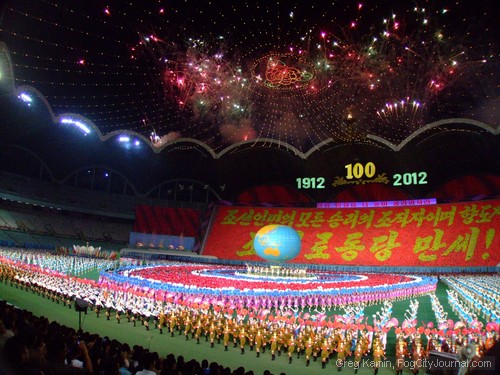
The Arirang Games, perhaps the most spectacular part of any visit to the DPRK celebrating the centennial of the “Great Leader” Kim Il-sung’s birth. It’s a monumental choreographed national tribute made up of 100,000 performers. The backdrop is an ever-changing picture formed by thousands of people holding cards. Photos by Greg Kamin.
By Greg Kamin
September 23, 2012
I tried to break the news to my father as casually as I could – almost as an afterthought. “I won’t be reachable for a while,” I said. “I’ll be out of town traveling through China and North Korea.”
Dead silence on the other end of the line. Followed by, after a long pause, “I didn’t think I heard you correctly.” His reaction was pretty typical of the one I got whenever I told folks I was joining a Global Exchange tour of the Democratic People’s Republic of Korea, as they prefer to be called.
“You are in our country now”
So what kinds of people would go to North Korea? People from all walks of life, as it turns out. The Bay Area was well-represented in our delegation of 7 women and 4 men, and we probably skewed more progressive than average. This was, after all, a Global Exchange group. But different political opinions were represented, including one person who used to work at the local Chamber of Commerce and has been actively involved in the campaigns of some local moderate politicians. Our group probably skewed older, though we ranged from a 32-year old social worker from Atlanta, to a 77-year old Korean Canadian who left South Korea during the US-backed military dictatorship of Park Chung-hee. What all of us did have in common, was that we were a well-traveled group, with some having visited over 70 countries. It probably couldn’t be otherwise, because North Korea isn’t exactly the first place most people would pick for a first trip abroad. But visiting North Korea was more than just about checking off another box. All of us had our reasons for going.
Mine, was that I wanted to get a glimpse of one of the most closed societies in the world. The world’s last Stalinist state, they say. The fact that the country is so closed and secretive – Americans have only been allowed to travel there since 2009 – is precisely what makes it so intriguing. I wanted to get beyond the “Axis of Evil” rhetoric, and see for myself what life is really like for people in the DPRK.
Not that a foreigner can exactly run wild in the DPRK. This isn’t Cuba, where locals and tourists alike can pretty much go wherever they want in the country and talk to whomever they please. “We have a saying in our country,” our guide, Mr. Lee, told us soon after he finished collecting our passports for the duration of the visit, on the bus from the airport. “When in Rome, do like the Romans do. You are in our country now, and in our country there are certain rules that need to be followed.” These rules include no pictures from the bus, no pictures of military, no pictures of anyone without asking permission for that matter; if you take a picture of one of the multitudes of statues and portraits of “Eternal President” Kim Il-sung and/or Chairman Kim Jong-il, you need to make sure you take the whole image, not just partial, and only from the front. And if you have a newspaper or magazine with a picture of the leader on it, you shouldn’t fold it or crumple it.
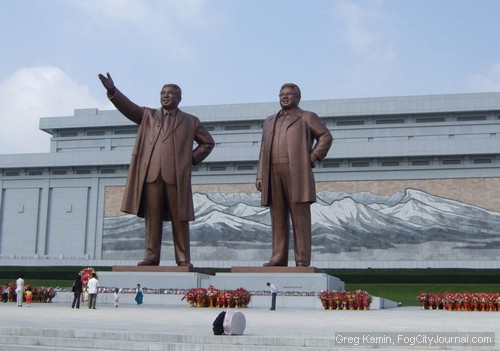
Twin statues of the late leaders of the DPRK, Kim Il-sung and Kim Jong-il.
Never much for obeying the rules, I of course immediately proceeded to take lots of pictures from the bus. After all, since we’d be forbidden to interact with ordinary citizens – especially without one of our two guides present, taking pictures from the bus was one of the best ways to capture slices of life that our guides didn’t want to focus on. I did, however, take care to be discreet, sensing that this is one place where the usual axiom that it’s easier to ask forgiveness than ask for permission, may not apply. To be fair, though, they never tried very hard to “see” us breaking this rule.
Other rules, like no pictures of the military, proved physically impossible to follow. In a country of 25 million people, some 9.5 million are either active duty military, or in a paramilitary or reserve unit of one sort or another. And all of them seem to wear their uniforms on or off duty, in every setting imaginable.
One thing our guides did make sure of, was that we didn’t have any unsanctioned contact with the locals. Even stepping out into the street from a souvenir shop on your own, elicited a guide running after you, nervously shaking their head. Underscoring the point, our massive 47-story hotel in Pyongyang was conveniently located on an island, with the entrance to the grounds guarded 24 hours a day -a prison tower complete with its own real-life moat. They probably didn’t need to be so vigilant. Even if we could bridge the language barrier, I’m not sure how much interaction we’d get from the locals. I noticed an odd phenomenon early on. While on the bus, people would stare at us -sometimes, if we made eye contact, they’d even smile and wave at these strange visitors who might as well be from Mars. But on the street, we’d be invisible. People would walk right by us as if we weren’t even there… except that you’d catch them giving us a sideways glance out of the corner of their eyes. Almost as if they were afraid of making any unsanctioned eye contact with the wrong people.
‘The Hunger Games’
There’s a certain elegance – beauty even – to the capital, Pyongyang. Wide boulevards and expansive public squares, flanked by imposing architecture and towering monuments that pay homage to the achievements of man and glorify the nation. Completely gone is the barrage of capitalist propaganda known as advertising, so pervasive in our lives that we no longer notice it permeating every square inch of our environment, along with its corollary of street litter composed of discarded brand-name paper products and multicolored wrappings. The color of Pyongyang is granite-gray, punctured only by colorful propaganda posters advertising the virtues of socialism and the great leaders of the country. The streets are sparkling clean. And everywhere, from massive statues and colorful billboards made from mosaic that never fades, to the portraits in every building, to the lapel pins that all citizens wear, you see the twin images of Dear Leader Kim Jong-il and his father, Eternal President Kim Il-sung (though never the current leader, Kim Jong-un).
Our guides paraded us through all the important stops – the Arch of Triumph (built to be several meters taller than the one in Paris, of course), the monument to the Korean Workers Party, Kim Il-sung Square, the Tower of the Juche Idea, etc.
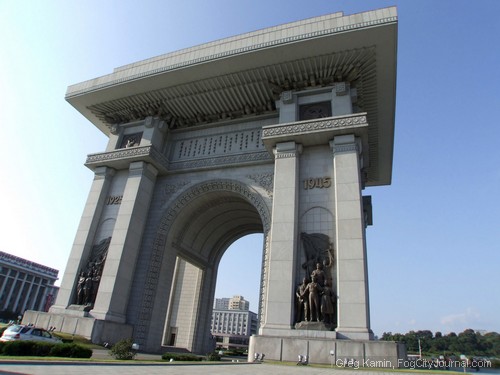
Arch of Triumph. 1925 is the year that Kim Il-sung embarked on the path of revolution (he would have been 13 at the time); 1945 was when he triumphed and founded the nation.
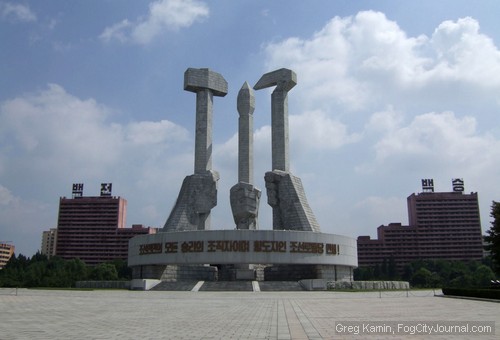
Monument to the Korean Workers Party. The hammer and sickle symbolize industry and agriculture. The brush symbolizes intellectuals and artists.
While admiring the views from the top, I pondered the internal contradictions of Juche, the overarching philosophy of the DPRK that blends nationalist self-reliance, Korean traditionalism, and Marxism. To the outsider, a philosophy of self-reliance may seem oddly hypocritical for a country that is often dependent on foreign aid. And yet, I can’t help but reflect on the observation that we too, have our very own homegrown “Juche philosophy” which has millions of adherents in the United States. Only instead of self-reliance of the nation, American Juche proclaims self-reliance of the individual, divorced from community. Thus the tea party member on Medicare and Social Security will emphatically maintain that government dependence is morally wrong. And the CEO who never had an original idea in his life will wax poetic about how he did it all on his own, oblivious to the privileged opportunities he received, the contributions of his workers, and the infrastructure that makes it all possible. And they believe it, just as blind to the internal contradictions, and with just as much fervor, as the citizens of the DPRK believe in Juche. Perhaps we shouldn’t be so quick to judge.
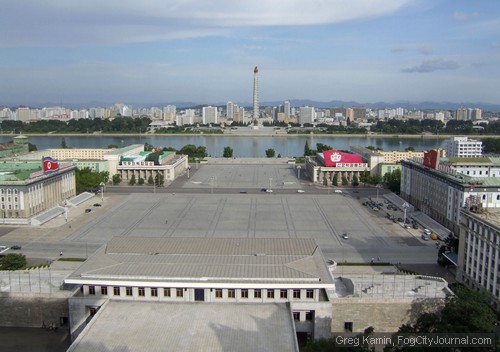
Kim Il-sung Square and the Juche Tower from the balcony of the People’s Study Hall.
Philosophy aside, I’ve always had a certain fondness for the monumental socialist-realist style of architecture. But after the 12th or 15th Big Monument, it all starts to remind me of the Capital City in The Hunger Games.
Perhaps more interesting were the parts of the trip that gave us a glimpse of daily life of DPRK citizens:
– A primary school, where we were treated to a children’s performance;
– The Pyongyang Maternity Hospital (certified as “Baby-Friendly” by UNICEF, according to the English-language plaque). The equipment looks like it’s Soviet-era, but other than that it’s not bad.
– The People’s Study Hall. More than just a central library, it’s a place where one can listen to music, browse the computers (“no internet – we have ‘intranet’ in our country,” said our guide in response to my question), and attend lectures on a whole variety of topics, and even go to an international book fair at the time of our visit, including a booth staffed by Korean Americans. One member of our delegation had to reflect on the whole incongruity of such a place in a country with so little freedom of thought. On a lighter note, I wondered how much use the typical citizen of the DPRK would have for such titles as Common Sense in Mutual Funds.
– An amusement park where the leader Kim Jong-Un personally tested the rides out to make sure they were safe for the people (now tell me, how often does President Obama do that?). If we wanted to ride, we could skip the lines. I passed, but it was nice to do some people-watching, seeing ordinary folks just out having a good time. Of course, “ordinary” by DPRK standards means that half of them are in their military uniforms. Still, it was not at all like other accounts I’ve seen, that made this amusement park seem like it was staged just for the tourists. It would be quite a production to get that many kids and young adults together to look and act like they’re having fun.
– The Pyongyang Metro -The two stations we went to are works of art, along the lines of the Moscow metro. Perhaps because they’re the only two stations that foreigners get to see, cynical rumors persist that there are only two stations, and the rest of the lines exist only on paper. I don’t think that’s true. I saw other stations throughout the city from the surface, and people do go in and out of them. I’m sure they’re not as nice, though.
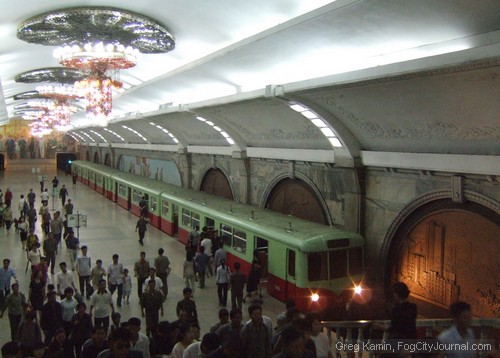
Pyongyang Metro.
Is it all staged? Some of it is, I’m sure. But at one point, one member of the group made the observation that if he were to take out-of-town friends on a tour of San Francisco, would he take them to the Bayview, or would he take them to North Beach and Alamo Square? If you’re going to show someone the New York subway, do you take them to Grand Central Station, or do you take them to one of those stations that looks like it’s straight out of the set of Escape From New York?
Ah, but of course the difference is that you could go see the Bayview, if you wanted to.
First Among Equals
Beneath the surface, however, there are signs that the system is straining. The huge public squares sit mostly empty. The mega-blocks of apartment buildings seem to get progressively more tattered the farther out from the center you go. And there is a certain contradiction in the fact that all those wide boulevards have almost no car traffic… or any traffic at all for that matter, except for the crowded busses and trolleys. Even the sharply dressed traffic wardens in their crisp white jackets and blue skirts, belie the fact that there are almost no traffic lights in Pyongyang. Whereas in Beijing crossing the street was a crazy adventure where any sort of vehicle could come at you from any direction, and all of them seemed to be trying to collect points for running down pedestrians, here in Pyongyang you could cross the street at “rush hour,” if such a concept even exists, without so much as bothering to look both ways. At least the air is free of the thick stew of hydrocarbons blanketing Beijing!
And electricity is not exactly abundant. The lack of cars and lack of streetlights contributes to the familiar satellite images of North Korea looking much darker than its southern neighbor. Contrary to the myth, however, there are lights in the city at night. Looking out at the city from the hotel, one can see that it’s not true that ” after 10pm much of the city is lit by candlelight, if at all,” as it says in the Lonely Planet Guide. But if it’s not dark, it’s certainly dim. It seems that the whole city is lit by 40 watt bulbs. Even in the hotel room, the lights are only barely adequate for reading, which somehow adds to the ambiance of the place.
Some, of course, live more privileged lives than others. Not everyone rides crowded trolleys and lives in tattered apartment buildings. Some ply the streets of Pyongyang in late model Mercedes sedans and Lexus SUVs. And there is a neighborhood that the tourists don’t visit. Though our guides claim they don’t know where the party elites live, it’s probably the part of Pyongyang marked as “the forbidden city” in the Lonely Planet Guide.
Most privileged of all are, of course, the Kim family. The Kims are more than leaders. To the people of North Korea, the Kims have assumed an almost god-like status. To us foreigners, however, it’s the ultimate cult of personality. Some of the more outrageous stories associated with that cult may be a bit overstated. At the sparkling new museum devoted to all the gifts the Kims have received over the years, I tried to test one. Coming across a set of golf clubs given to Kim Jong-il, I asked the guide if he ever used it. She said “no.” I said, “I hear he was a very good golfer,” hoping to elicit the story of his legendary 38 under-par game. The guide played it straight, though, and said she wasn’t sure. Still, the cult is alive and well. A photo of the marble-framed portrait of Kim Jong-il, dressed as a knight in shining armor, and mounted astride a ferocious tiger… that would have been priceless. Alas, no cameras were allowed.
The Provinces and the Potemkin Farm
If the capital resembles The Hunger Games, what do the provinces look like? We passed a lot of villages on the largely empty highways on the way to Kaesong in the south, and Wonsan, a port city in the east. Along the way they took us to a “typical” collective farm, filled with happy people, children singing and dancing on cue in a primary school, and even one of the few tractors I’d seen on the trip. And of course the obligatory mosaic of Kim Il-sung. Our host told us, with no hint of irony, that Kim Il-sung came and told them that in order to make life better for the people, his advice was that they should plant more corn and grow more rice. How profound!
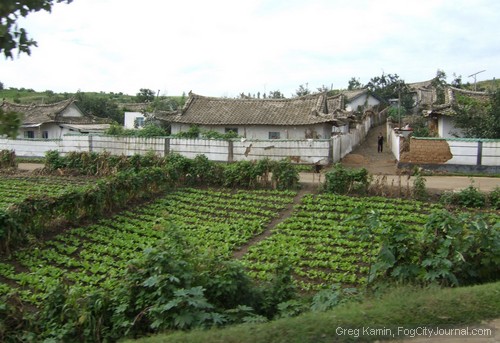
A typical village in the DPRK, passing by on the bus.
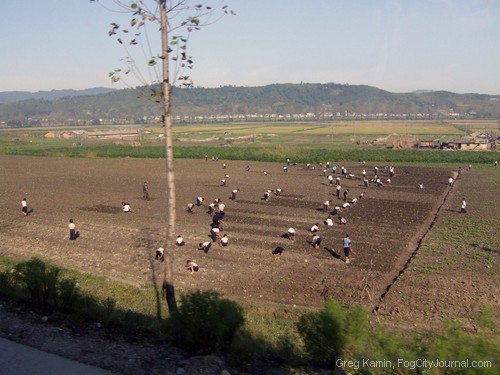
Children work the fields in the countryside, DPRK.
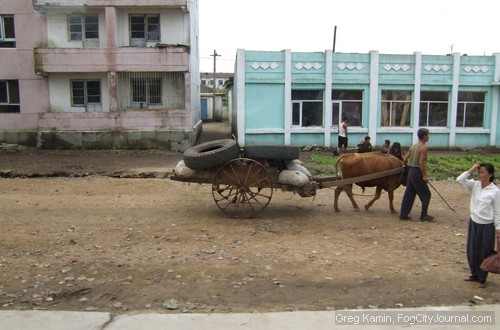
Passing by an oxcart in Sinchon.
That the farm was clearly a showcase, was painfully obvious. That said, it’s easy to overstate the conditions in the DPRK. A few of the villages look a bit run-down, and I saw at least one group of uniformed schoolchildren tending the fields -likely a manifestation of the government’s policy of making even city dwellers go out into the fields at harvest time. But to be honest, I didn’t see the “grinding poverty” that the guidebook said was apparent as soon as you leave the capital. Most people live fairly simply – small homes in the countryside, or multilevel flats in the towns. Almost no cars and few bicycles; most people walk, or else just wait on the side of the road, probably for infrequently-running transport. There are some oxcarts here and there. And a lot of the trucks seem to run on coal. But “grinding poverty?” Honestly, I’ve seen much, much worse in some capitalist countries. Here, at least there are electric lines in some pretty remote places. The service may be of dubious quality (I wouldn’t be surprised if even PG&E is better!). But it’s there. In places like Peru, half the population lives on $2 a day, electricity is non-existent out in the countryside, and a bath means a dip in the river.
Finally! The Stuff We’d All Heard About!
We were beginning to wonder when we’d get a real dose of anti-American propaganda… “imperialist dogs” getting crushed and stuff like that. The propaganda is certainly ubiquitous – in the streets, on the TV, etc. But it’s not overtly and ubiquitously anti-American. I guess our hosts didn’t want to set a bad tone for the whole trip, so they saved that part pretty much for the last couple days… finally taking us to the Pueblo Museum (a US spy ship captured by the DPRK under disputed circumstances in 1968. The crew was eventually repatriated after a written apology to the DPRK, but they kept the ship); the Demilitarized Zone between North and South Korea, where they explained how on this [North] side there are only shot guns, but on the other side facing them is a massive force backed by nuclear weapons; the war memorial to the struggle against the 1910-1945 Japanese occupation (most of the heavy fighting was done in the North, though our hosts conveniently gloss over the fact that without Soviet forces, Kim Il-sung’s partisans wouldn’t have been able to expel the Japanese); and a museum devoted to the Sinchon Massacre, a series of incidents during the Korean War in which the DPRK claims that American forces massacred 35,000 civilians. An elderly resident, one of only 3 children to survive a particularly terrible incident where US forces allegedly burned hundreds of children alive in a warehouse, gave a moving account of his own personal recollections.
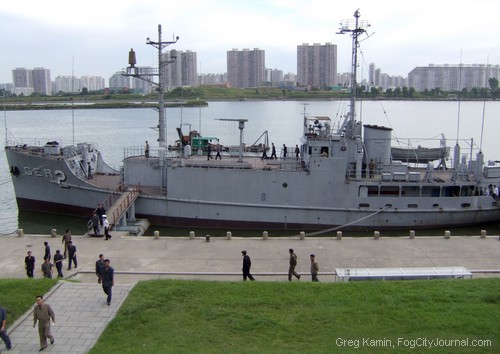
The captured USS Pueblo.
Many in our group were dubious of the claims, in whole or in part. In our own country, like in most others, we grow up with certain narratives that shape our belief systems. One of those narratives is that American military force is used for good in the world, and our forces never commit atrocities or murder civilians. In their country, they have the opposite narrative. To them, the US and allied nations committed all the atrocities of the Korean War, and their side never deliberately killed innocent civilians. For all the times our guide told us he “didn’t know” something or gave us an evasive answer, one question he was absolutely certain of the answer to, was when he was asked whether the North Korean forces ever committed massacres. “Never.” I suppose it would be as difficult for him to accept that, as it was for the Americans in our group to accept that US forces would murder civilians. This is the side of the Korean war you don’t get here. This is their narrative. Their truth.
I’ve heard it said that the DPRK is stuck in a time warp… refusing to get past the Korean War. By our standards, I suppose it’s not that hard to get over… they even call it the “forgotten war” here. But from their point of view, it’s not as easy. There’s a reason Pyongyang looks like a showcase for Stalinism, and it’s not just because it was Kim Il-sung’s preferred aesthetic. The city was bombed to pieces during the Korean War by the US.
But there’s something even deeper than that. Any visitor to the DPRK soon comes to understand that deeply embedded in the Korean psyche are two overarching themes -unification, and independence from foreign powers. The citizens of the DPRK are a proud people. They fiercely defend the right to shape their own destiny, free from the intervention of foreign powers. And they long for the day when Korea will once again be united as one nation. That’s why the Korean War is such a thorn -it was a conflict where great powers on both sides used Korean territory to advance their geopolitical agendas, and it still divides Korea to this day. Whichever side you come down on, I think their reluctance to “move on” is understandable when viewed through that lens.
So what is life really like on the other side of the Bamboo Curtain? I’m not sure that question was ever completely answered. I’m not sure it ever could be, on a one-week trip. Even under the best conditions, and these were certainly not the best conditions. But I certainly did get a different picture than the one you see in the American corporate press. It’s a picture of a people who are fiercely nationalistic and worship their leaders with god-like devotion. How much of that is reverence and how much is fear, it’s hard to tell. One does get the feeling, that one day, when things are different, a large segment of the population will long for the days when choices were simple and the streets had no cars. It’s tempting to draw parallels to Eastern Block nations, but the DPRK doesn’t really have good parallels. Unlike in the latter days of the Soviet Union or East Germany, there are no jokes about the party leaders, there is no undercurrent of subversion. It’s not a free country. It’s not a country I’d like to live in, with my healthy disdain for authority. It’s a repressive dictatorship, evocative of 1984. But it’s their dictatorship. They don’t have military bases all over the world imposing their system. They’re not occupying anyone else’s land. Their repression is theirs to solve. And eventually, I believe they will. In their own way. On their own time. Ultimately, people are people. Beyond the rhetoric and demonization on both sides of the divide, North Koreans are people -people who go to work, get married, go to amusement parks and cinemas, in short not that much different than people anywhere else. And it was worthwhile to see that side of a country that few outsiders ever get to see.
More photos
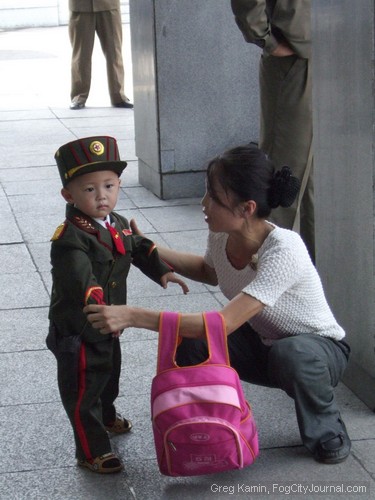
A camera-shy little soldier. They teach ’em young. He actually ran away but his mother brought him back to pose.
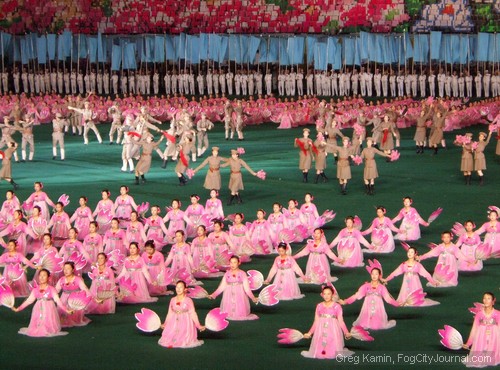
Arirang Games, DPRK.
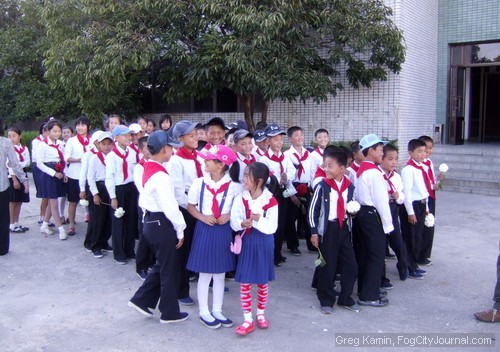
Young DPRK Pioneers at camp, basically socialist Boy Scouts.
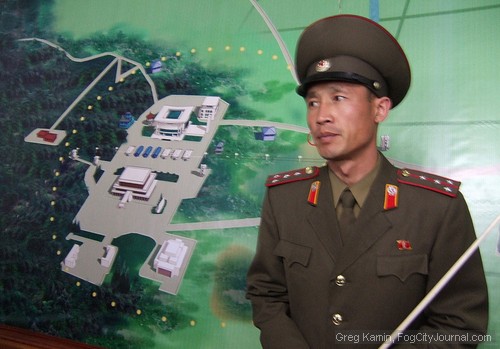
A DPRK soldier at the DMZ (demilitarized zone) explaining North Korea’s version of the war with the U.S.


 The Hunger Site
The Hunger Site
July 8, 2016 at 11:58 am
Obviously this tourist had no pics of the real North Korea because not only is North Korea the least developed country on Earth, but in fact, life in North Korea is far worse than life in Pelican Bay State Prison! North Korea as a whole is literally like a supermax prison!
October 22, 2012 at 2:39 pm
Hi Greg,
Just got to read this – I think it is an excellent article – I really enjoyed it!
I do feel compelled to mention the conversation I had with a German woman on the plane on the way back to Beijing who spent most of her trip in the northern part of North Korea. For whatever it is worth, she told me that the people there were friendlier and smiled more and the children eagerly waved to travelers further north. She also said they had no hot water at all and little / intermittent electricity – and that the people clearly had less food.
That said, I agree with what you have stated about what we saw – which was, of course, limited. I did not see quite the terror and poverty that I had anticipated around Pyongyang at all. Im calling this my “magical mystery” tour as so much remains a mystery after having been there.
Stephanie
October 9, 2012 at 1:49 pm
Hi Greg…love the article..so in depth. The pics from the bus are awesome. Enjoyed traveling with you
Marcia
September 24, 2012 at 3:13 pm
What,
I think you have a point, and I did acknowledge that point. I’m well aware that we weren’t shown the worst of it. However, it’s also important not to overstate the point. The media here tends to focus on the very worst only. Very few people have been there, even among those who write articles about the country. Much of what we hear comes from defectors, who have their own “party line” like the other side.
There’s a lot that’s wrong in the DPRK, and there’s also a lot of hyperbole out there. Note, the Lonely Planet Guide referred to “grinding poverty” not as something which exists hidden away in places they don’t want you to see, but as something that’s *readily apparent* *as soon as you leave the capital*. Now we traveled through a wide swath of the country side. And while it’s not a land of plenty by any stretch, the description of “grinding poverty” being the norm throughout the country is simply NOT the case, at least in comparison to places like India, Africa, or parts of Latin America.
I tried to write a balanced piece. I talked about the negative and the positive. In fact, I think our hosts would see this piece as much more negative than positive. What I didn’t want to do is veer into the sort of hyperbolic demonization you get everywhere else, because frankly it’s not an accurate portrayal. No country is all evil, or all good. But when the only information you’re accustomed to seeing, is all negative, then anything remotely balanced between negative and positive seems completely out of step. In going with an open mind, I wasn’t being “dismissive” of any point of view. All I would ask is that you re-read what you wrote, and take your own advice.
September 24, 2012 at 11:08 am
Of course you didn’t see grinding poverty, because your tour guide didn’t let you go to the many places where it exists. Did you honestly think you would be allowed to see anything that negative? You’ve seen worse in free countries because you were free to go wherever you please. Undercover journalists have shown it in North Korea, at risk to their lives. There are none so blind as those who do not want to see…please do not be so dismissive.
September 24, 2012 at 6:27 am
i enjoyed your article but i am not sure about the concept of “it’s there dictatorship”… how could it be “theirs” if they are under constant threat from the state?
September 23, 2012 at 10:49 am
El Greco,
I did mention it, in that I said they’re dependent on foreign aid. By all accounts, it’s not as bad as it was in the 90s. But rationing is still a fact of life, though our hosts of course tried to gloss over that aspect. Many the countries of the Communist Block had a very difficult time in the 90s. Some, like Cuba, recovered better. Others, like the DPRK, not so much. The recent typhoon didn’t help matters either. Our schedule had to be re-arranged because some of the places on our itinerary were flooded out. And even where we did go, we passed a few flooded fields.
Truth is, you’re never going to get a complete picture on short guided tour of any country. If you were to visit the United States on a guided tour, would you learn that 1 in 5 children is at risk of hunger, living in a household considered “food insecure?” Probably not.
One of many reasons I prefer independent travel is that you can get a better sense of the place than you often get on a guided tour. In the DPRK, that’s unfortunately not possible. But I do think that going there gives you a *more* complete perspective than you could get just from the media.
September 23, 2012 at 10:35 am
Love the communist subway porn.
September 23, 2012 at 7:55 am
Not a word about the food shortages in DPRK.